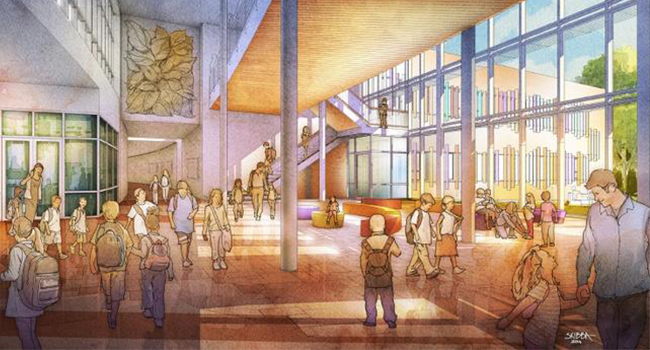
New Sandy Hook School Built with Invisible Security Measures
- By Sydny Shepard
- Dec 14, 2015
When the 2016 school year starts, students and faculty will return to Sandy Hook Elementary for the first time since a gunman killed 20 students and six adults. However, they will be returning to a brand new building that was designed thoughtfully to include security measures designed by local architectures.
The town of Newtown, Connecticut demolished the former building last fall, nearly a year after the shooting after realizing how hard it would be for students, teachers and facility to return to a building filled with horrific memories, like the parking lot where police gathered terrified children and faculty after evacuating them from the school on the morning of December 14, 2012.
Svigals + Partners were given the opportunity to design a building that would be able to create a sense of security and embrace around those who will always remember those lost during the shooting. The architecture firm found it increasingly important to create a school that had many invisible security measures.
Many of Svigal’s subtler security details have to do with the entrance of the building. Buses can pull up through a curved driveway, but staff will park in one lot and visitors in another, helping school officials keep track of who is coming and going. By re-landscaping the entrance, the architects honored the community’s wish to not revisit the original parking lot, where students and families were held as police arrived on the scene that fateful day.
Once visitors reach the school grounds, they pass through more strategic, yet invisible security measures. After Sandy Hook, school districts around the country began focusing intently on security systems like fences, guards and shatterproof glass at entries. The new Sandy Hook will have impact-resistant windows and an intercom screening system for visitors, but the architects also found a way for the landscape work in their favor.
For instance, to reach the entrance, visitors must cross one of three bridges that connect the front doors to the parking lots. To avoid the feeling of a fortress protected by a moat, the architects are turning those bridges into rain gardens that collect and filter runoff rainwater. They’ll be an educational tool, rather than a security checkpoint.
The school has also been pushed back away from the road and closer to the nearby wetlands; this affords a more expansive view of the entrance from the building, which makes it easier to spot people approaching.
Svigals + Partners was fortunate to have enough acreage to weave security measures into the surrounding landscape. That’s not a luxury enjoyed by all schools, particularly those in urban settings. But the new Sandy Hook has lessons for all schools. For example, the ground floor is elevated a few feet about the ground. An assailant approaching from outside will be lower than anyone he might wish to harm. And students can still learn in classrooms with big windows, nice views, and plenty of light.
“It’s not a barbed wire fence, it’s a combination of natural elements,” principle at Svigals + Partners, Jay Brotman said. “You have to look at this through the eyes of the children who would be attending it.”
About the Author
Sydny Shepard is the Executive Editor of Campus Security & Life Safety.